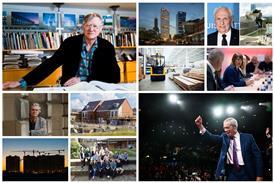As the construction industry makes strides in sustainability, Anna Beckett asks why we can’t achieve even more in the year ahead

Yesterday morning, as I sat in a chilly site office in my Christmas jumper (a spectacular item of clothing that I’ve had for about 10 years), I realised that we had spent almost half of the meeting talking about the implementation of sustainability-led ideas. We had discussed temporary works requirements to maximise retention of existing building fabric, the use of CLT, and the practicalities of steel reuse.
These items weren’t discussed as though they were unusual or innovative ideas; they were simply part of the construction works on the project. When I think back to projects even two years ago, it’s hard to imagine those conversations taking place in quite the same way, if at all.
When it comes to sustainability, it often feels like progress is moving at a glacial pace, and that both metaphorically and literally the glacier will have melted by the time we get anywhere. It’s easy to feel disheartened, but in 2024 the construction industry made some huge steps forward, as well as setting the groundwork to continue doing so in 2025.
In particular, the conversation around the reuse of existing buildings changed pace, with the controversy around the proposed M&S demolition bringing the topic to the top of the agenda. Whether or not you agree with the decision, there’s no doubt that we’re now having much more considered conversations about the buildings we already have, and we’re asking better questions about the way we’re treating them. The introduction of Westminster council’s retrofit-first policy has helped to prioritise building reuse, and while of course it’s not always possible, the discussion about whether a particular building should be retained or demolished has become much more holistic.
> Also read: Westminster council unveils plans to become a ‘retrofit-first’ city
2024 also saw the publication of the UK Net Zero Carbon Buildings Standard, a document which aims to define an industry-wide approach that can be used to demonstrate that assets are “net zero carbon.” A unified definition is a great achievement for the industry, and the ability to compare projects on a like-for-like basis means that we can really start to see where we are making progress and where we need to work a little bit harder.
So let’s take a step back, give ourselves a well-deserved break, and come back refreshed and ready to make even bigger changes in 2025
And when it comes to material reuse, we have started to see the skills we’ve learnt from smaller projects implemented at a much larger scale. We’re figuring out the logistics of removing and re-fabricating steel from the sites we’re working on, and whilst there are still challenges to be overcome (especially when it comes to storage), steel reuse is no longer a theoretical idea. Concrete reuse is rather more problematic, but we’re researching and testing ideas that might make this possible.
So what’s next? Where will we be by the end of 2025? And what should we be trying to achieve?
It certainly seems like the reuse of steelwork is likely to become more mainstream, and there’s a huge amount of momentum in the industry to make this happen. At some point, we might be able to incorporate reused steelwork into the supply chain as easily as “new” steelwork, and maybe by the end of 2025 we’ll be heading towards that. But hopefully, we’ll also start to see the reuse of other materials accelerate and develop some better systems to facilitate this.
I hope that we will start to consider more than just the embodied carbon of the materials we’re using. Embodied carbon has been a great measure to get the whole industry thinking about our impact on the environment, but it’s just one way of measuring the impact of our work. As we move through 2025, perhaps we can start to consider the impact we’re having more holistically, including the biodiversity impacts and water use involved in material extraction – both things we rarely consider at the moment.
As we wind down for the holidays and tuck into our Quality Streets (in recyclable paper wrappers), there’s lots to feel positive about. Maybe the change isn’t happening as quickly as we’d like, but we have made progress, and there are plenty of other examples that I could have included. So let’s take a step back, give ourselves a well-deserved break, and come back refreshed and ready to make even bigger changes in 2025.
> Also read: Climate and industry leaders lay out new rules to prove buildings meet net zero carbon
Postscript
Anna Beckett is an associate director at Buro Happold















No comments yet